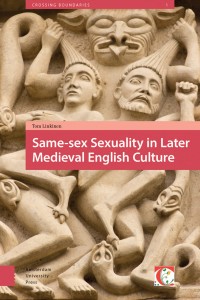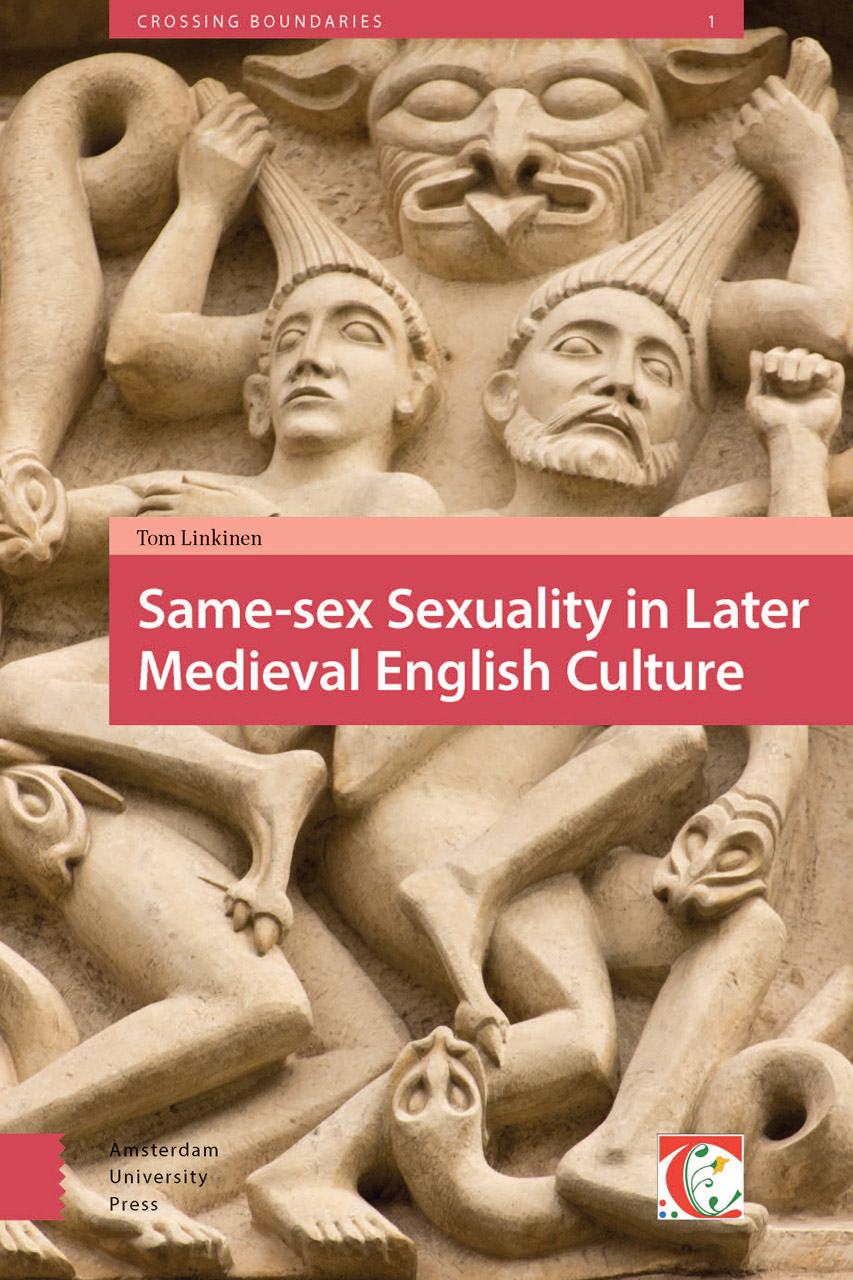 Same-Sex Sexuality in Later Medieval English Culture
Same-Sex Sexuality in Later Medieval English Culture
by Tom Linkinen
Amsterdam University Press
334 pages, $99.
IN 1394, according to London court records, one John “Eleanor” Rykener was arrested after being caught cross-dressing and having sex with a man in a public stall. Rykener admitted to other acts of prostitution. He described living and working as a woman in several towns. While playing a passive sexual role with men, he claimed to have sex with women as the active partner. Contemporary historians have a hard time fitting Rykener into our sexual categories: homosexual, gay man, transvestite, transsexual. His crime was simply the commission of “unnatural” acts, but it’s clear that “unnaturalness” could refer to multiple deviations of sex, morality, gender, and even politics, as we shall see.
Tom Linkinen’s monograph on same-sex sexuality in late medieval England tackles these issues in a scholarly yet approachable way.
At the outset, Linkinen sets out the conundrum for the contemporary historian of gay and lesbian sexuality. How do we document something that has long been condemned and therefore not written about—either in the Middle Ages or by (straight) historians until recently? The gay historian has to be especially creative in searching for euphemisms, reading between the lines, and entertaining expressions of same-sex devotion as intimations of something carnal. Much of the documentary evidence Linkinen examines has been analyzed by recent scholars such as John Boswell, Carolyn Dinshaw, Alan Bray, and Ruth Karras, but Linkinen re-examines a huge array of material. Some may be familiar: for example, two kings rumored to be sodomites (Edward II and Richard II), the Knights Templar, and “The Pardoner’s Tale” from Chaucer’s Canterbury Tales.
If there weren’t gays and homosexuals in medieval England, then what was there? Most commonly, texts condemn “sodomy” and the “sin against nature,” or, as one writer from 1300 defined it, “all such delight that is not between a man and a woman.” However, the many religious texts that discuss (and inevitably condemn) sodomy cover quite a range of sexual and even nonsexual activities. The original story of Sodom and Gomorrah in the book of Genesis is ambiguous as to the exact transgression of the Sodomites that merited the town’s destruction by fire and brimstone. In medieval usage, unnatural acts could refer to almost any sexual act outside of marital procreation, including onanism (masturbation). Since heretics would also be accused of sodomy, heresy and sodomy became almost synonymous. Some texts would even conflate lust and lechery in general with sodomy in a seemingly fanatical impulse to heap shame on suspected sinners. I’m reminded of former Senator Rick Santorum’s conflation of “man on man” with “man on dog” sexuality.
The political implications are most evident in the cases of the two kings and the Knights Templar. Both Edward II and Richard II had developed bad reputations by the Elizabethan age, as would be memorialized in plays by Marlowe and Shakespeare. At best, both were accused of doting on their preferred (male) counselors; at worst they were accused of sodomy. Although there was much contemporaneous gossip about their behavior with their favorites and their sodomitical inclinations, there is no definitive evidence. It’s possible that accusations of sodomy were a political weapon used against them for their poor governance and political missteps. Edward’s “sworn brother,” Piers Gaveston, was caught in a political tug of war between the king and his barons. Gaveston was married with children, yet was so beloved by the king that, despite multiple exiles, he always returned to his side. The king’s enemies eventually had Gaveston captured and executed in 1312. He was replaced in the king’s affections by Hugh Despenser the Younger, who in 1326 would be publically humiliated, castrated, and quartered amid accusations of being a “heretic and guilty of unnatural practices, even with the King, whose affections he had alienated from the queen” (according to a later chronicler). Edward was deposed by his spurned wife, Isabella of France, and by their teenage son in 1327. He soon died mysteriously in prison; rumors circulated he was murdered by having a red hot poker shoved up his anus to emphasize his reputation as a sodomite.
Richard II was also an unpopular king, having acceded to the throne when just ten years old in 1377. Gossip about the “unmentionable seducers of the king” and his “drinking bouts and other unnameable things” circulated shortly after his forced abdication in 1399. Perhaps the rumors were an attempt to justify his imprisonment and mysterious death through guilt-by-association with his great-grandfather, Edward II. Linkinen again emphasizes how difficult it is to pin down a historical figure’s sexuality, especially when it’s considered “unmentionable.”
The overlay of political and personal slander is even more striking in attacks on the Knights Templar and the Lollard movement (a mid-14th century Reformation sect). Lollards and their Catholic opponents each accused the other of sodomy. Lollards were the first to be burned at the stake for heresy as well as sodomy. One poet cried: “The race of Lollards is the vile race of Sodom.” Accusations of heresy, treachery, and sodomy were the tinder that sent the Knights Templar to the stake. The military order had been created in the 12th century to fight in the Crusades and in the process had accrued great wealth and power. However, with the fall of the Holy Land in 1291, the Knights lost political clout and were disbanded by the Pope in 1312. They were accused of blasphemous and sodomitical initiation rites, and many confessed under torture before being burned. The Templars’ substantial land holdings were seized, and huge royal debts to them went up in smoke. Are these just examples of a royal land grab, or might there be some trace of sexuality there? It remains a challenge in this era “before sexuality.”
“Sworn brotherhood,” as between Edward II and Gaveston is perhaps the most abundant yet ambiguous evidence of same-sex sexuality. John Boswell enthusiastically interpreted these references as evidence of gay marriage in the pre-modern era. Other historians have been more circumspect, if not outright hostile to such an interpretation. While it may be impossible to know what was in the heart of medieval same-sex couples (let alone what they did in bed), the many accounts of love are compelling. Quite poignant is the story of the so-called “gay knights,” Sir William Neville and Sir John Clanvowe, knights of the royal chamber of Richard II (again, guilty by association?). Clanvowe was a poet and friend of Chaucer’s; he was a follower of the Lollard doctrine and fought in the Crusades. He never married, but his sworn “brother in arms” was Sir William Neville. They died in Galata outside Constantinople in 1391 and were buried together at a Dominican church that was later turned into the Arap Mosque. Their joint tombstone was discovered there in 1913 and is now in the Archaeological Museum in Istanbul, labeled simply “Tomb Slab of an English Couple.” It shows two feather-festooned helmets face-to-face, almost kissing and, below these, two identical shields inclined against each other bearing “impaled” coats of arms (as would be done for married nobility). According to the chronicle of Westminster Abbey:
It was also on 17 October that in a village near Constantinople in Greece the life of Sir John Clanvowe, a distinguished knight, came to its close, causing to his companion on the march, Sir William Neville, for whom his love was no less than for himself, such inconsolable sorrow that he never took food again and two days afterward breathed his last, greatly mourned, in the same village. These two knights were men of high repute among the English, gentlemen of mettle and descended from illustrious families.
Other examples of “sworn brotherhood” or “spiritual brotherhood” among historical and literary couples are romantic and suggestive, but it was the very absence of erotic implications (at least at the time) that allowed them to be laudable.
The only physical evidence of eternal friendship among medieval women is a brass memorial in Etchingham, East Sussex, from 1480, of two spinster women buried jointly. Linkinen concludes that the relegation of women to a domestic and undocumented sphere leaves us with little tangible evidence of love between women. Instead, we have only texts condemning (in as oblique language as possible) masturbation or other sexual acts between women, particularly in religious orders. Love or sex in the nunnery is hard to document, alas. Nonetheless, Linkinen’s work will be satisfying reading for those fond of the middle ages, and who also appreciate the cultural and political complexities of love and sexuality of all times.
Vernon Rosario is a child psychiatrist and historian of science in the Department of Psychiatry at UCLA.






